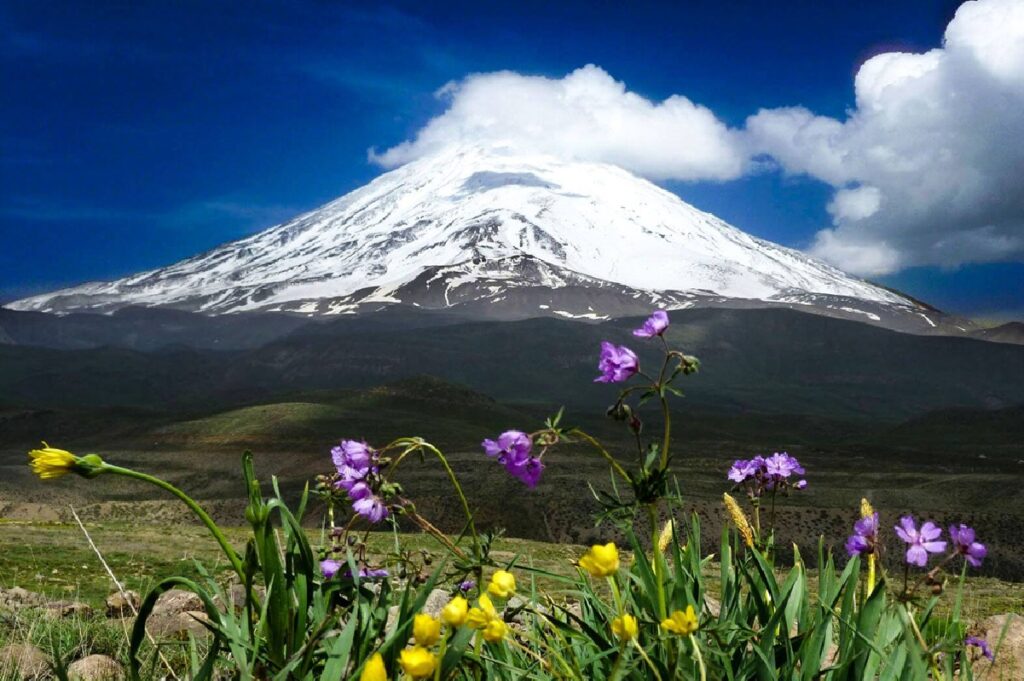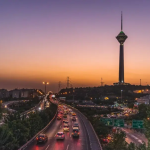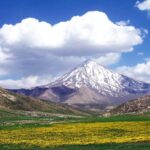To give you the Alborz mountains location, I should say that it stretched 900 km long along the Caspian Sea is one of two major mountains ranges in Iran. Starting from Azerbaijan in northwest to Khorasan in northeast, the Elborz Mountain range makes a boundary between the Caspian Sea and the central Iran. The two highest peaks of Iran, Damavand and Alam Kouh, are located in the Alborz Mountain range.
This range was formed over millions of years by the collision of the Eurasian and Arabian tectonic plates, which led to the creation of a diverse geological landscape.
The origin of Alborz
The Alborz Mountain range was formed in the Alpine orogeny phase in the later Mesozoic era, as the result of the collision of the Arabian plate with the Iranian plate. The range is home to a mix of sedimentary and volcanic rocks. With approximately 700 kilometers length and 150 kilometers width, these high peaks and deep valleys make a huge arc-shaped border between the Caspian Sea and the central plateau of Iran. Due to this, Alborz caused two completely different climatic at two sides.

Tourist attractions of Alborz Mountains
The massive structure of the Alborz Mountains location provides a diverse range of landscapes for different types of activities from snow covered peaks to lush valleys. Here are some of the most famous natural and cultural attractions on the Elborz mountains:
- Famous ski resort of Dizin and Shemshak are appropriate slopes for skiing from November to April.
- Damavand peak which is highest volcano in the Asia serves as an ideal location for hiking and trekking.
- Alam Kouh great wall is the second high peak but the first big wall in Iran. This vertical 550-meter granite wall demands professionality and rock-climbing skills.
- The sulfurous hot springs near Damavand volcano are other tourist attraction that welcomes everybody during autumn and winter.
- The mysterious Alamut valley is a cultural and natural tourist attractions of Alborz Mountains heights. The remains of nearly 50 castles from the medieval ages are located on the slopes of the Alborz peaks. Visiting these castles of the assassins after a nice trek along the awe-inspiring landscapes of Alamut valley is amazing.
- Badab Sourt springs are amazing natural pools made of travertine located at an altitude of 1841 on Alborz Mountains location. The beautiful orange color is the result of high concentration of iron oxide sediments. These springs are surrounded by wild bushes and other flora types.
Alborz Ski Region
The most prominent ski resorts in Alborz Mountain Range are Dizin, Tochal, Shamshak, Darbandsar and Abali.
Dizin ski resort
Dizin ski resort that is located 80km far from Tehran is the biggest with the most comfort facilities that persuades many ski fans to travel to Iran and experience the ultimate pleasure of skiing there. It is good to know that after Dizin Ski Resort attracted the attention of World Ski Federation, it was entitled as an international resort for championships.
also read : tourist attraction in Iran
Tochal ski resort
Tochal is a popular resort 50km far from Tehran. For this reason, the track of this area with modern and advanced equipment is the number of sports lovers in all winter days. This ski resort is about 1,200 meters long that starts from Tochal peak at 3,800 meters and extends to the vicinity of the hotel of this complex.
Shamshak ski resort
Shamshak ski resort located 60km far from Tehran. The big plus of this slope is that it not only has a day slope but also provides a night slope for the people who are free from 18:00 to 22:00.
Abali ski resort
Abali ski resort is suitable for both beginners and professionals, even for the ones who don’t plan to ski. An advantage of Abali ski resort over other resorts is the variety of entertainment and equipment there; where you can enjoy other winter activities.
Alborz Hiking Mount
It is interesting to know that the mountainous regions have made Iran a special and unique country for hiking. Plan for a hiking adventure on numerous spots to breathe fresh air along the green hills and full-of-flower valleys, cross high waterfalls and rest in intact villages. Let us introduce you some tempting hiking trails as tourist attractions of Alborz Mountain range.
Talesh Hiking Routes
Along Talesh hiking trail you can start from the Caspian Sea coasts to the Gilan forests and continue to visit the Neor Lake.
Damavand Hiking Routes
Damavand is the most prominent natural attraction in Iran. The people who are not capable of climbing to the peak can take advantage of the beauty of this mountain at the hiking trails on the slopes and Lar national park.
Alamout Valley Hiking Routes
During years of history, Almout valley was a living place of many people who left their legacy behind. Numerous hiking routes take you along the Alborz mountains heights to visit the historical castles and high-altitude forests. You can follow the footsteps of Freya Stark in Alamut valley.
Trekking in Alborz Mountains
There are numerous peaks along the vast Alborz Mountain range, each one has its own special features but among all those we introduce you the most famous trekking routes in Elborz.
also read : discover Alvand mountain
Damavand Mount
The first popular peak is Damavand which is the highest peak in Iran. There are 20 routes to reach the peak but considering the accessibility to facilities and shelters, the best climbing routes are the four southern, western, northern and northeastern routes. Among those the easiest one is through the Southern flank as tourist attractions of Alborz.
Adventure seekers can explore the Alborz and Zagros mountain ranges through specialized Iran Tour Packages focused on hiking and mountaineering.
Alam Kouh Mount
Alam Kouh mountain is accessible from Kalardasht city in north of Iran. Trekking to Alam Kouh peak can be done through several route but its two main routes are through the north face or Alamchal glacier and the south face or Hesarchal plain. Through the south flank you will have an easy and successful ascend but along the north flank you will face the 600m almost vertical great wall so you need to have the climbing techniques and proficiency.
also read : all about Zagros mountains
Conclusion
The Alborz Mountain range that extends about 1,500 kilometers between the Caspian Sea and the plate of Iran is an important geographical feature in the north of Iran. The enormity of Alborz Mountains caused a diverse range of ecosystems and climatic conditions that creates awe-inspiring natural landscapes such as the highest and well-known summits in Iran and Asia. For thousands of years people inhabited in the slopes and created a rich historical heritage such as the Alamut valley. Whether you are interested in hiking, skiing, or simply experiencing the natural and cultural beauties of this magnificent mountain range, there is something available for you.





















